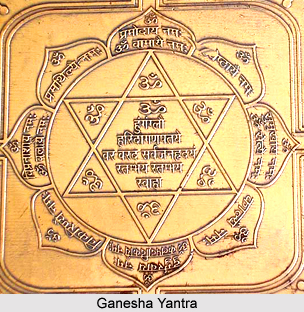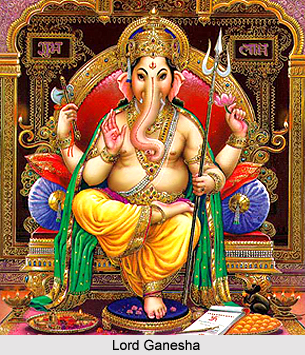 Ganesha Yantra is a divine diagram which blesses the devotees of Lord Ganesha with the will to focus and achieve their aims and objectives. The Yantra possesses control over heavenly and cosmic forces. It is a sacred storage of energy that receives cosmic rays released by the different planets and converts those energies into positive vibrations. These energy vibrations are spread in the atmosphere where the Ganesha Yantra is situated. As a result, the confidence and strength of the devotees improves and helps them in achieving success in all their ventures. It also removes all the negative and destructive energy in the area. The Ganesha Yantra is generally created of copper. It is a conductor of cosmic energy; a tool for success and prosperity; and helps in meditation, yoga and attaining good health. The Ganesha Yantra comprises of several geometric patterns. The worshipper should focus at the centre of the sacred diagram in order to attain higher levels of consciousness.
Ganesha Yantra is a divine diagram which blesses the devotees of Lord Ganesha with the will to focus and achieve their aims and objectives. The Yantra possesses control over heavenly and cosmic forces. It is a sacred storage of energy that receives cosmic rays released by the different planets and converts those energies into positive vibrations. These energy vibrations are spread in the atmosphere where the Ganesha Yantra is situated. As a result, the confidence and strength of the devotees improves and helps them in achieving success in all their ventures. It also removes all the negative and destructive energy in the area. The Ganesha Yantra is generally created of copper. It is a conductor of cosmic energy; a tool for success and prosperity; and helps in meditation, yoga and attaining good health. The Ganesha Yantra comprises of several geometric patterns. The worshipper should focus at the centre of the sacred diagram in order to attain higher levels of consciousness.
It is believed that when a worshipper prays to the Ganesha Yantra, he is blessed with the positive energy of Lord Ganesha. Moreover the intelligence and cognitive skills of the person improves and his mathematical skills are also enhanced. A person should pray to the Ganesha Yantra before beginning a new business or a new project to eradicate all hindrances.
 Lord Ganesha or Ganapati is the son of Lord Shiva and the Leader of the Ganas (divine army of Shiva). The worship of Lord Ganesha can be performed by conducting puja of the Ganesha Yantra.
Lord Ganesha or Ganapati is the son of Lord Shiva and the Leader of the Ganas (divine army of Shiva). The worship of Lord Ganesha can be performed by conducting puja of the Ganesha Yantra.
Rituals for worshipping the Ganesha Yantra are mentioned below-
Before worshiping the Ganesha Yantra the devotee should have a bath and purify his body. He should start the rituals with a pure and positive mind:
* The performer is required to be seated on the floor facing towards the east direction.
* The Ganesh Yantra should be placed on a sacred altar along with the idol of Lord Ganesha and the favourite deity of the worshipper (Ishta Devata).
* Then fresh fruit and flowers are offered and kept on the altar. The devotee should also light lamps (Diya) and incense sticks (Dhoopa).
* The performer is required to sprinkle holy water on the Ganesha Yantra and himself. The water can be sprinkled with a leaf of any tree.
* The devotee should also chant the holy mantra "Aum Gam Ganapathaye Namaha" for twenty-one times.
* The devotee should pray to the Lord and the Ganesha Yantra and ask for blessings to fulfill his desires.




















